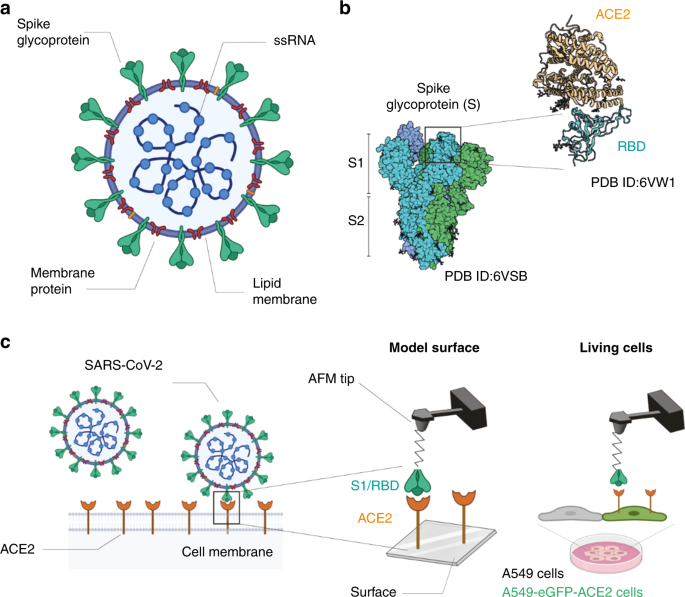Other ACE2 expressing cells include AT1 cells airway epithelial cells fibroblasts endothelial cells and. A BHK-21 cells transiently expressing ACE2 of human or bat origin human APN or human DPP4 were inoculated with pseudotyped VSV harboring VSV-G SARS-S SARS-2-S MERS-S or 229E-S.
 Molecular Interaction And Inhibition Of Sars Cov 2 Binding To The Ace2 Receptor Nature Communications
Molecular Interaction And Inhibition Of Sars Cov 2 Binding To The Ace2 Receptor Nature Communications
Lung carcinoma cell line.

Ace2 expressing cells. We found that human iPS cells expressing the SARS-CoV-2 receptor angiotensin-converting enzyme 2 ACE2 ACE2-iPS cells can be infected w SARS-CoV-2. ACE2 is an enzyme expressed on the cell surface in various tissues including lungs arteries heart kidney and intestines. Of 30 cell lines and primary cells examined productive severe acute respiratory syndrome coronavirus Urbani strain SARS-CoV infection after low-multiplicity inoculation was detected in only six.
It is however also important to study other tissue locations that could serve as potential entry. Membranous expression in ciliated cells in nasal mucosa bronchus and fallopian tube. Prior studies of ACE2 expression have primarily focused on mRNA abundance with investigation at the protein level limited by uncertain specificity of commercial ACE2 antibodies.
InvivoGen offers HEK-Blue hACE2 cells which. Critically this injury was attenuated by blocking the renin-angiotensin pathway and depended on ACE2 expression 12. The majority of the ACE2-expressing cells averagely 83 are AT2 cells.
Antibody staining with HPA000288 CAB026174 CAB026213 CAB080024 CAB080025 CAB080027 and CAB080028 in immunohistochemistry. Three African green monkey kidney epithelial cell lines Vero Vero E6 and MA104 a human colon ep. Interestingly this receptor was highly enriched in epithelial cells of tongue.
At 16 h postinoculation pseudotype entry was analyzed normalization against particles without viral envelope protein. Humans use different airway epithelial cells for replication. Expression of ACE2 in alveolar type II AT2 cells would thereforesuggest that these cells can serve as a reservoir for viral invasion and facilitate SARS-CoV-2 replication in the lung.
ACE2 gene expression has been verified by qRT-PCR FACS staining and functional assays. Membranous expression in proximal renal tubules intestinal tract seminal vesicle epididymis exocrine pancreas and gallbladder. Expressed in endothelial cells and pericytes in many tissues.
Within the alveolated parenchyma ACE2 expression is predominantly observed in type II pneumocytes or alveolar type II AT2 cells and alveolar macrophages. These findings suggest that the ACE2 plays an important role in cellular entry thus ACE2-expressing cells may act as target cells and are susceptible to 2019. In infected ACE2-iPS cells the expression of SARS-CoV-2 nucleocapsid protein budding of viral particles and production of progeny virus double membrane spherules and double-membrane vesicles were confirmed.
Overexpression of human ACE2 enhanced disease severity in a mouse model of SARS-CoV infection demonstrating that viral entry into cells is a critical step 11. Expression of ACE2 in B-cells tissue. 70 Zeilen lung cell lines.
Summary of ACE2 expression in human tissue. For all donors ACE2 is expressed in 064 of all human lung cells. AT2 cells expressed ACE2.
Injecting SARS-CoV spike into mice worsened lung injury. Small cell lung carcinoma. ACE2 expressing HEK293 cells HEK293 NF-κB-reporter cells expressing the SARS-CoV-2 receptor ACE2.
All 12 samples from our ventilated cohort showed histologic features of diffuse alveolar. Expressed in Sertoli and Leydig cells and trophoblasts. Exogenous ACE2 expression allows refractory cell lines to support severe acute respiratory.
Antibody staining with HPA000288 CAB026174 CAB026213 CAB080024 CAB080025 CAB080027 and CAB080028 in immunohistochemistry. Preliminarily those findings have explained the basic mechanism that the oral cavity is a potentially high risk for 2019-nCoV infectious susceptibility and provided a piece of evidence for the future prevention strategy in dental clinical practice as well as. Discovered as a homologue of ACE ACE2 acts as its physiological counterbalance providing homeostatic regulation of circulating angiotensin II Ang II levels.
The membrane protein angiotensin-converting enzyme 2 ACE2 is a physiologic regulator of the renin-angiotensin system and the cellular receptor for the SARS-CoV-2 virus. The results demonstrated that the ACE2 expressed on the mucosa of oral cavity.
